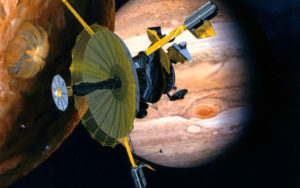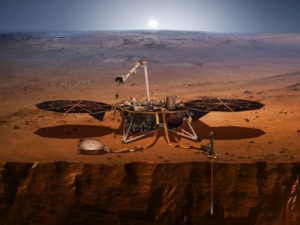It’s another wild week in space so get right in there. If you feel moved to join us, start here.
The Pressure Inside Every Proton is 10x That Inside Neutron Stars
Matt Williams | Universe Today
Neutron stars are famous for combining a very high-density with a very small radius. As the remnants of massive stars that have undergone gravitational collapse, the interior of a neutron star is compressed to the point where they have similar pressure conditions to atomic nuclei. Basically, they become so dense that they experience the same amount of internal pressure as the equivalent of 2.6 to 4.1 quadrillion Suns!
In spite of that, neutron stars have nothing on protons, according to a recent study by scientists at the Department of Energy’s Thomas Jefferson National Accelerator Facility. After conducting the first measurement of the mechanical properties of subatomic particles, the scientific team determined that…
NASA Cubesat Takes a Picture of the Earth and Moon
Matt Williams | Universe Today
In 1990, the Voyager 1 spaceprobe took a picture of Earth when it was about 6.4 billion km (4 billion mi) away. In this image, known as the “pale blue dot“, Earth and the Moon appeared as mere points of light because of the sheer distance involved. Nevertheless, it remains an iconic photo that not only showed our world from space, but also set long-distance record.
As it turns out, NASA set another long-distance record for CubeSats last week (on May. 8th, 2018) when a pair of small satellites called Mars Cube One (MarCO) reached a distance of 1 million km (621,371 mi) from Earth. On the following day, one of the CubeSats (MarCO-B, aka. “Wall-E”) used its fisheye camera…
Are Mysterious Fast Radio Bursts Coming From the Collapse of Strange Star Crusts?
Matt Williams | Universe Today
Fast Radio Bursts (FBRs) have fascinated astronomers ever since the first one was detected in 2007. This event was named the “Lorimer Burst” after it discoverer, Duncan Lorimer from West Virginia University. In radio astronomy, this phenomenon refers to transient radio pulses coming from distant cosmological sources, which typically last a few milliseconds on average.
Over two dozen events have been discovered since 2007 and scientists are still not sure what causes them – though theories range from exploding stars and black holes to pulsars and magnetars. However, according to a new study by a team of Chinese astronomers, FRBs may be linked to…
There was Evidence for Europa’s Geysers Hiding in Plain Sight in Old Spacecraft Data From 1997
Matt Williams | Universe Today
Jupiter’s moon Europa continues to fascinate and amaze! In 1979, the Voyager missions provided the first indications that an interior ocean might exist beneath it’s icy surface. Between 1995 and 2003, the Galileo spaceprobe provided the most detailed information to date on Jupiter’s moons to date. This information bolstered theories about how life could exist in a warm water ocean located at the core-mantle boundary.
Even though the Galileo mission ended when the probe crashed into Jupiter’s atmosphere, the spaceprobe is still providing vital information on Europa. After analyzing old data from the mission, NASA scientists have found independent evidence that Europa’s interior ocean is venting plumes of water vapor from its surface. This is…
Ted Cruz and Bill Nelson give NASA a Reality Check on Privatizing International Space Station
Mark Whittington | The Hill
Recently the Senate Subcommittee on Science, Space and Competitiveness held a hearing on the future of the International Space Station. Sen. Ted Cruz (R-Texas) the chair of the subcommittee, and Sen. Bill Nelson (D-Fla.), the ranking member of the full Senate Commerce Committee, were in attendance. Bill Gerstenmaier, the NASA associate administrator for Human Exploration and Operations, and Paul Martin, the NASA Inspector General, were the witnesses.
The actual title of the hearing should have been “Why the Trump administration’s plan to privatize the ISS by 2025 is not happening.” Both Cruz and Nelson were…
China Launches Communications Satellite Called Queqiao Toward the Moon
Mark Whittington | US Blasting News
China launched the first part of its latest probe to the moon in the form of a communications satellite called Queqiao, which translates to English as “Magpie Bridge.” The name is derived from an ancient Chinese legend about two lovers who separated by the Milky Way who are helped by a flock of magpies which builds a bridge with their bodies.
What will Queqiao do?
Queqiao is headed for the Earth-Moon L2 point 37,000 miles behind the moon, where the gravities of the two worlds cancel out. The satellite will orbit around that point in space and will provide a communications link with the Chang’e 4 lander and rover, currently…
24 Hours of Light
Kimberly Arcand and Megan Watzke | Chandra X-Ray Observatory Blog
Light is something we experience every day. For most people, “light” refers to what humans can detect with our eyes. It is illumination, what ignites our visual sense, the yin to the yang of dark. However, the type of light humans can detect with our eyes is just a small fraction that exists, and the true nature of light is much more expansive.
In many ways, light behaves like a wave and this is the key to understanding its amazing capabilities. How tightly packed — or far apart — the waves are dictates light’s properties. For example, the longer the wave, the less energy the light typically carries, and vice versa. Each type of light has…
Sagittarius A* Swarm: Black Hole Bounty Captured in the Milky Way Center
Kimberly Arcand and Megan Watzke | Chandra X-Ray Observatory Blog
Astronomers have discovered evidence for thousands of black holes located near the center of our Milky Way galaxy using data from NASA’s Chandra X-ray Observatory.
This black hole bounty consists of stellar-mass black holes, which typically weigh between five to 30 times the mass of the Sun. These newly identified black holes were found within three light years — a relatively short distance on cosmic scales — of the supermassive black hole at our Galaxy’s center known as Sagittarius A* (Sgr A*).
Theoretical studies of the dynamics of stars in galaxies have indicated that a large population of stellar mass black holes — as many as 20,000 — could drift inward over…
Robert Zubrin has New Propellantless Space Propulsion Concept – Dipole Drive
Brian Wang | Next Big Future
Robert Zubrin was an inventor of the magnetic sail with Dana Andrews when they looked at the drag of a magnetic scoop intended for a Bussard ramjet. The magnetic sail would be great for a lighter braking mechanism for interstellar laser pushed vehicles.
Robert also was a reviewer for the electric sail paper. It also has drag and has positive charge that pushes against the solar wind.
Robert has thought up something he previously called an enhanced electric sail but now calls the dipole drive.
He has two screens one positive and one negative. Outside of the screens the positive and negative cancel out but between them there is strong field going from…
Zubrin Moon Direct Plan
Brian Wang | Next Big Future
Zubrin has detailed creating a moon base within 4 years using a few SpaceX Falcon Heavy missions.
10 kilometer power beaming is a key to creating lunar fuel.
Once we have lunar fuel production, we can use Falcon 9 to launch missions.
He wants to use a lunar vehicle with…
Bezos and Blue Origin Will Work with NASA and ESA for Moon Base
Brian Wang | Next Big Future
Jeff Bezos says his Blue Origin space venture will work with NASA as well as the European Space Agency to create a settlement on the moon.
Even if Blue Origin can’t strike public-private partnerships, Bezos will do what needs to be done to make it so, he said here at the International Space Development Conference on Friday night.
Bezos laid out his vision for lunar settlement during a fireside chat with Alan Boyle, which took place just after he received the National Space Society’s Gerard K. O’Neill Memorial Award.
In the short run, Blue Origin’s objective is to…
And… That’s a wrap! Stay tune for more Carnival of Space fun when Bring Wang offers CoS #654 on his site: Next Big Coins.








































Pingback: Carnival of Space #563 | Citizen Science
Pingback: Carnival of Space #563 – Renfrewshire Astronomical Society
Pingback: Carnival of Space #563 | March for America | MFA News